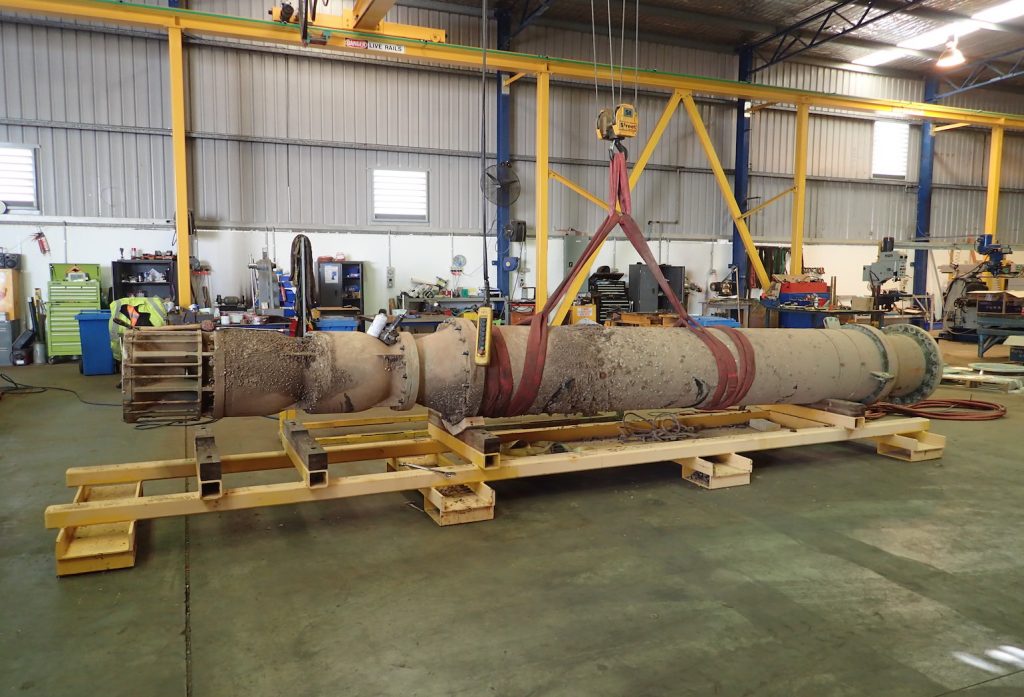Engineers at Water Corporation were initially puzzled why corrosion found inside a faulty seawater pump was 65,000 times higher than expected.
As many engineers working on desalination plants or in offshore oil and gas know, dealing with corrosion around seawater is a core challenge. While protection from aggressive corrosive environments can be offered by using the right materials, other unforeseen factors can also come into play.
Water Corporation is the principal supplier of water, wastewater and drainage services to more than 2 million people state-wide. We take pride in providing services at the lowest whole-of-life cost to the WA community. One of our facilities is a seawater pump station supplying more than 800 litres of seawater per second, to industrial customers in Burrup, Dampier every day.
First built in 2004, the pump station is located on a jetty at the Toll Supply Base of the peninsula. Three large 373 kW high voltage bore pumps sit inside caissons and travel through three kilometres of water piping supply, with a brine return line. They’re configured so two are always running, with a third on standby.
After a few years of smooth operation, our team of engineers were suddenly surprised to detect high levels of corrosion and several unexplained mechanical failures.
The super-duplex stainless steel (SAF2507) pumps were commonly used across the oil and gas industry for offshore equipment and well suited to corrosive marine environments. However, each time the pumps were inspected after previous failures, they showed levels of corrosion that were far more advanced than they should be and a reason for the mechanical failures was still very unclear.
After one of these unexplained failures led to the disposal of a $600,000 pump after just four years in service, the team decided it was time to call in some help from the Curtin Corrosion Centre.
“We were unable to pinpoint what the source of the corrosion was, but we knew that it was much higher than it should be just by looking at the severity of the damage inside the pump,” said Adam Graham, Senior Technical Advisor, Mechanical Field Support Engineering at Water Corporation.
“With one pump already out of commission ahead of its time, we knew we had to get to the bottom of the problem before the same thing happened to the other pumps.”
For the past 35 years, the Curtin Corrosion Centre has been a world-class research centre in conducting corrosion and materials research for a range of clients and industry partners, including Shell, Santos, Chevron and Woodside. Their expertise in various types of corrosion in Australia is unmatched.
Using parts and samples from the damaged pump, the research team tested two theories; mechanical failure due to corrosion or weakening from Sigma Phase (chromium-rich particles that form during uncontrolled heat treatment), or corrosion due to electrical stray currents.
While the team did find small amounts of sigma phase in some of the welded areas of the sample, they were too low to be considered a significant contributing factor given the extensive corrosion and were quickly ruled out.
Stray currents occur when direct electrical current flows outside of its intended path and they can cause electrolysis corrosion at their point of discharge. One of the tests for this is to see if hydrogen, a byproduct of the cathodic effect, has been reabsorbed into the material causing hydrogen embrittlement.
In the case of the damaged pump, the results came back to show that the parts contained 4 ppm of hydrogen. Further motor tests with generated stray current also confirmed it to be an issue.
“The results from the Curtin Corrosion Centre were very clear, and it gave us the source of the problem so that we could get on with developing a solution. It will save us from other expensive pump repairs or replacing another of the main pumps before schedule,” said Adam.
The Water Corporation team have since made significant improvements to the pumps by repairing high voltage cable terminations on motor cables to be compliant with industry standards, and added shaft grounding ring to reduce the risk of motor generated current. Testing using specialist monitoring equipment to ensure that stray current corrosion is no longer an issue at the site is ongoing.
If you would like to discuss similar issues around corrosion or learn more about the processes at Water Corporation, please send an email to adam.graham@watercorporation.com.au.

